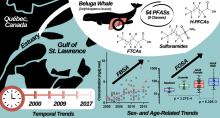| Title | Quantitative Chemical Proteomics Reveals Interspecies Variations on Binding Schemes of L-FABP with Perfluorooctanesulfonate |
| Publication Type | Journal Article |
| Year of Publication | 2021 |
| Authors | Han, JJ, Fu, J, Sun, JX, Hall, DR, Yang, DW, Blatz, D, Houck, KA, Ng, CA, Doering, JA, LaLone, CA, Peng, H |
| Journal | Environ. Sci. Technol. |
| Volume | 55 |
| Issue | accepted |
| Abstract | Evaluating interspecies toxicity variation is a long-standing challenge for chemical hazard assessment. This study developed a Quantitative Interspecies Thermal Shift Assay (QITSA) for in-situ, quantitative, and modest-throughput investigation of chemical-protein interactions in cell and tissue samples across species. By using liver fatty acid binding protein (L-FABP) as a case study, the QITSA method was benchmarked with six per- and polyfluoroalkyl substances (PFAS) and thermal shifts (∆Tm) were inversely related to their dissociation constants (R2=0.98). QITSA can also distinguish binding modes of chemicals exemplified by palmitic acid. The QITSA was applied to determine the interactions between perfluorooctanesulfonate(PFOS) and L-FABP in liver cells or tissues from human, mouse, rat, and zebrafish. The largest thermal stability enhancement by PFOS was observed for human L-FABP, followed by mouse, rat and zebrafish. While endogenous ligands were revealed to partially contribute to the large interspecies variation, recombinant proteins were employed to confirm the high binding affinity of PFOS to human L-FABP, compared to rat and mouse. This study implemented an experimental strategy to characterize chemical-protein interactions across species and future application of QITSA to other chemical contaminants is of great interest. |
Environmental Chemical Biology

